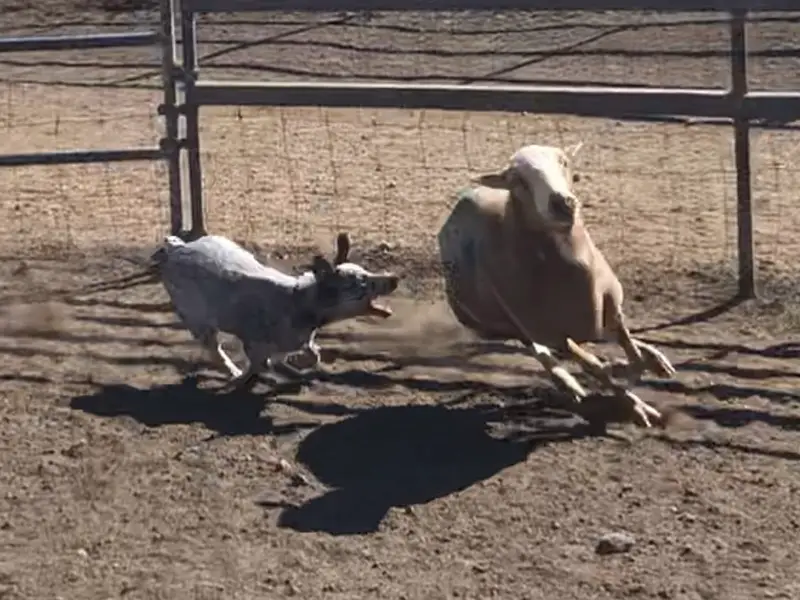After watching the daily ritual of coordinated chasing the squirrels, I realized my dogs were doing so like a wild dog pack. Banjo would bark and take the lead running directly at the squirrel while Bindi would stalk and try to intercept with the intention of catching it, which thankfully, they never have. It got me thinking, is this behavior built into all ACDs? What I discovered was consistent with what I’ve been observing in my own yard.
Australian Cattle Dogs (ACD) tend to have a very strong prey drive since they are bred for herding, an activity that relies on the same chase instinct. Australian Cattle Dogs (ACD) are known for their strong prey drive, which is an animal’s instinct to locate, chase, catch, and consume prey.

When a Cattle Dog, also known as a Heeler, is not herding, hunting, running an agility course, or otherwise using its prey drive it can become a nuisance or even be seen as aggression. So, how can we know if a Cattle Dog has a strong predatory drive and how can we redirect it so it doesn’t cause problems? First, let’s uncover why Cattle Dogs have a high prey drive.
Why Do Cattle Dogs Have a High Prey Drive?
Cattle Dogs have a very high prey drive due to a few basic reasons.
- As carnivores, a dog’s instinct is to locate and capture prey as a matter of survival. This instinct is stronger in some breeds such as Cattle Dogs, especially since they were bred with Australian Dingos in the mid-1800s. In the wild, the Dingo’s prey drive signals it to stalk, chase, catch and consume small animals and birds to survive. The relatively recent introduction of wild Dingo DNA gives the Cattle Dog a tendency towards a high prey drive.
- Chasing another animal also provides satisfaction and triggers the pleasure center of a Cattle Dog’s brain. A good chase or herding session gives an ACDs a rush of endorphins. In the mind of a Cattle Dog, chasing a moving target satisfies their herding instinct and need to perform a task.
- The American Kennel Club classifies the Australian Cattle Dog as part of the Herding Group. For herding, it’s necessary to stalk, chase, and nip at the animals being tended, in other words, it requires a strong prey drive. Fortunately, the drive to kill and consume prey has been bred out of ACDs.
In summary, an ACD was born to chase other animals or moving objects, therefore their prey drive is quite strong.
How Do I Know if My Cattle Dog has a Strong Prey Drive?
If your Cattle Dog likes to chase cars, cats, rodents, squirrels, birds, small children, or other dogs at the park, or if they express interest in an endless game of fetch or frisbee, then your dog likely has a strong prey drive.
It should be noted that chasing other animals can be predatory, unwanted, and considered aggressive if not kept in check or tamed.
How Can I Tame Prey Drive in My Cattle Dog?
First, until your Cattle Dog’s prey drive is tamed, it’s important to keep them leashed, crated, and safe from harm or potentially harming other creatures.
Next, it’s helpful to examine the underlying need to chase, practice recall commands, substitute the chase tendency with new behaviors, and provide consistent rewards for the correct behaviors.
Train to Tame Prey Drive
Structured training is needed to curb a Cattle Dog’s inclination to chase other animals. Training using commands like come, drop it, leave it, drop down, and come away. For such a high prey drive, it is recommended to find a local trainer experienced with herding or working breeds.
Fortunately, Australian Cattle Dogs are one of the top ten most intelligent dog breeds, so they tend to respond to training very quickly. However, due to their higher intelligence, they require a slightly different approach to training. ACDs respond better to positive reinforcement and redirection than they do to punishment.
How Much Training Does It Take to Tame Predatory Drive?
After basic manners and obedience lessons, training Cattle Dogs’ to resist the chase instinct can take between two and four months to show significant improvement.
It helps to have a trainer experienced with ACDs. We were lucky enough to find a local trainer who helped us redirect our Cattle Dogs’ instinct to chase. She used whistles, rewards, and recall commands.
For example, of our two Heelers, our female, Bindi, inherited more of the wild streak. At the park she would target a smaller dog to chase and nip, never meaning harm. In her mind, she’s trying to get it back to the group, but to the owner and dog, it’s not always welcome.
Finally, after several months of training, when called, she disengages from the chase and returns to us!
Final Thoughts
It’s important to recognize that a Cattle Dog has a strong prey drive to avoid any unwanted chase habits. Once prey drive has been identified, structured training will help a Cattle Dog learn how to exhibit proper social behavior and develop into the loyal, obedient companion they were meant to be!
